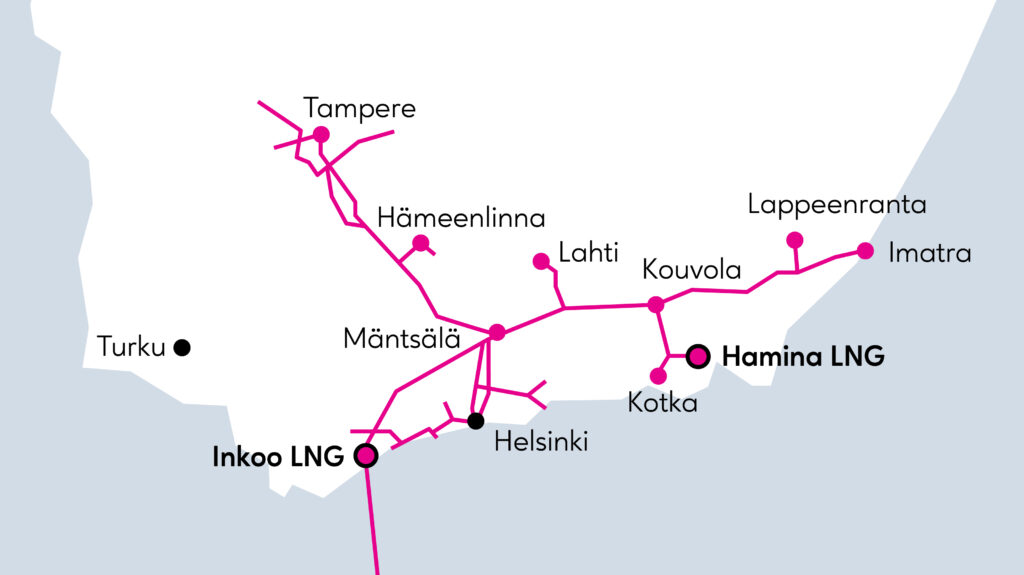Gas transmission network
The high-pressure gas transmission network consists of interconnected natural gas pipes and related equipment intended for natural gas transmission or distribution.
Finland’s gas transmission network includes two points that cross state borders; Imatra border point and Balticconnector connection point.
During 2022, two LNG terminals were connected to the transfer platform with new connecting pipes; Hamina and Inkoo LNG terminals. Biogas is fed into the gas system through five Finnish biogas plants.
The import of Russian natural gas to Finland through the Imatra border point was ended on May 21, 2022.

- Contact us:
- customerservice@gasgrid.fi
Transmission pipelines
Finland’s high-pressure transmission pipelines total 1,150 km in length and are made of steel pipes, most of which are coated with polyethylene plastic. In addition to high-pressure pipelines, the transmission network also features 60 km of low-pressure pipelines. The protection against corrosion provided by the gas pipeline coating is supplemented by a cathodic protection system. The oldest sections of the pipelines were taken into use in 1974. The diameter of the transmission pipelines ranges between DN100 and DN1000. 80% of the pipelines can be inspected internally.
The transmission pipeline network also includes a 77-km offshore steel pipeline from Paldiski, Estonia, to Inkoo, Finland, which is jointly owned with the Estonian transmission system operator for electricity and gas, Elering. The interconnector pipeline can be operated in both directions. The offshore pipeline’s diameter is DN500 and its design pressure is 80 bar.
Compressor stations
Compressor stations are used to raise gas pressure and that way increase the transmission capacity of the gas network. The compressor stations (located in Imatra, Kouvola and Mäntsälä) have a total of 8 gas turbine-operated compressor units with a total combined shaft power of 54 MW. In addition to these, Gasgrid Finland operates the Ingå compressor unit driven by an electric motor and with capacity of 6.4 MW.
Valve stations
There are valve stations installed at intervals of 8–32 km along the transmission pipeline network. Their safety cut-off devices can be used to cut off gas transmission and distribution and release gas from a pipeline section using a measure called blowdown. The total number of valve stations is 166, and 40 of these are remotely controlled.
Link stations
Gasgrid Finland has its own data transmission system with link stations via which the network’s operating, monitoring and alert data is submitted to the Kouvola Central Control Room that is staffed 24/7.
Pressure reduction stations
Pressure reduction stations form part of the transmission pipeline system. The stations are located at the customer interface close to customers’ distribution pipelines or processes. The pressure reduction stations are used to regulate gas pressure to a level suitable for the customer. The volume measurement of gas transmitted takes place at pressure reduction stations.
Gas odourisation
Gas is odourised before delivery to customers. In special cases, gas can also be delivered unodourised, but this requires a permit from the Finnish Safety and Chemicals Agency (Tukes).
Gas network also used for biogas
In addition to natural gas, renewable biogas from four different Finnish biogas plants is injected into the gas transmission network. The biogas plants are located in Espoo, Kouvola, Lahti and Riihimäki. In addition to the above, a biogas plant located in Hamina is connected to the distribution network.



